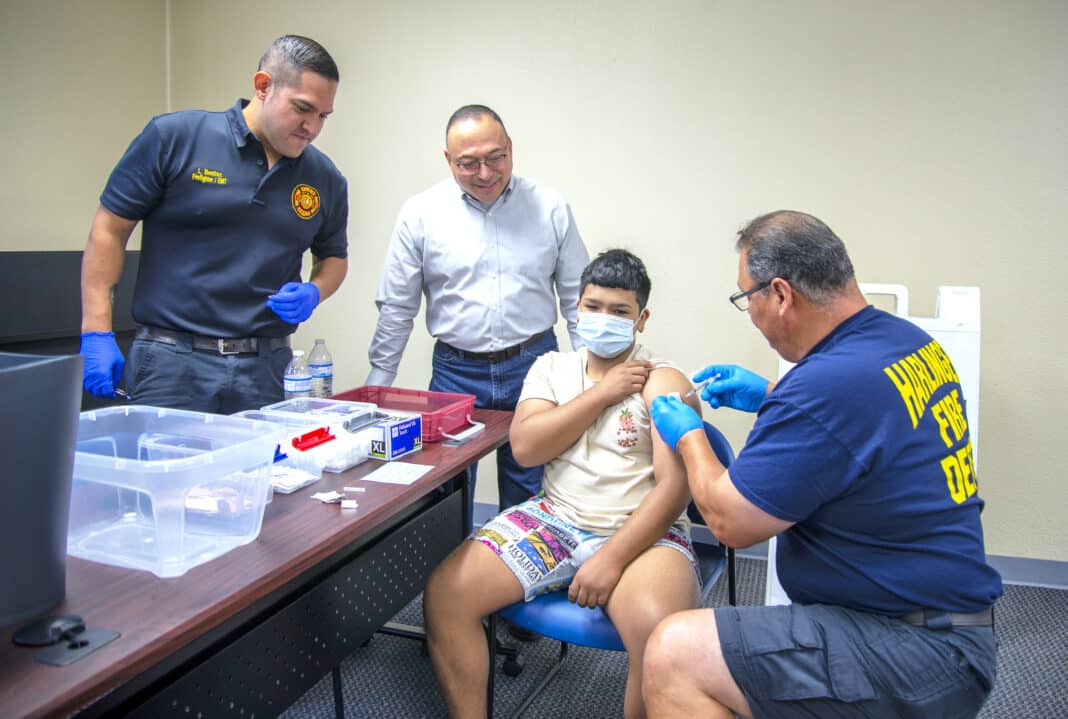HARLINGEN — The Rio Grande Valley’s vaccination rate stands among Texas’ highest after residents here struggled with one of the nation’s steepest COVID-19 death tolls.
Now, the region is striving to reach “herd immunity,” with about 70 percent of residents 12 and above receiving at least one shot, helping the population create resistance to the spread of the coronavirus.
“The Rio Grande Valley’s vaccination rates have always been pretty high across the board, so I’m not surprised,” Esmeralda Guajardo, Cameron County’s health administrator, said. “People here believe in science and what medical doctor’s say.”
Factors behind the region’s high vaccination rate include painful lessons learned during the pandemic, when the Valley’s high rates of obesity, diabetes and hypertension led to one of the state’s most staggering death tolls.
“One of those factors was fear,” Guajardo said. “There’s the emotional aspect — so many people have died and people don’t want to be a statistic. The vaccine is a solution.”
Painful lessons
During the summer of 2020, the Valley’s death rate ranked as one of the nation’s highest.
On Aug. 24, Cameron County’s death rate stood at 2.89 percent, Hidalgo’s at 4.94 percent, Starr’s at 4.20 percent and Willacy’s at 5.17 percent, according to medpagetoday.
Based on its population, Willacy County’s death toll ranked among the top 10 in the United States, the third-highest in Texas, Raymondville Mayor Gilbert Gonzales said at the time.
Across the Valley, new COVID-19 cases were soaring to daily levels of more than 1,300, pushing hospitals over capacity.
Meanwhile, the region’s death toll was climbing to more than 15 a day.
Now, as more residents become vaccinated, new COVID-19 cases — along with the death toll — are plunging.
On Friday, Cameron and Hidalgo counties reported a total of 119 new cases, along with three deaths.
In Cameron and Hidalgo counties, about 70 percent of residents 12 to 64 years old have received at least one vaccine dose, while about 57 percent are fully vaccinated, according to state figures released this past week.
Meanwhile, about 87 percent of the twin counties’ residents 65 and older have received at least one shot, with about 78 percent fully vaccinated.
Across the Texas-Mexico border, vaccination rates stand among the highest in the state.
While about 40 Texas counties boast rates above the state average, border counties make up about a third of those.
In Harlingen, Josh Ramirez, the city’s public health director, believes the city has already reached herd immunity.
“I feel comfortable we’ve already reached herd immunity,” he said. “As more of the population gets vaccinated, the risk of the virus spreading lessens.”
Ramirez said the region’s struggle amid one of the state’s highest death tolls led public health officials to push the state to send more vaccine doses to boost vaccinations.
“We were demonstrating the need and demand for it,” he said. “Our population is more susceptible to obesity and diabetes, which contributed to the deaths so we all pushed for vaccines realizing our vulnerability.”
Driving to boost rates
Now, the city’s vaccination program is launching a campaign aimed at immunizing the rest of the population, Ramirez said.
“Our goal is to continue pushing to reach as close as we can to 100 percent,” he said.
Across the area, public health officials are facing less resistance from residents holding out on taking the vaccine, he said.
“There is some resistance but not as we’ve seen in other parts of the country,” he said. “I think the Valley’s people understand the need for the vaccine. We are all related to someone with underlying conditions.”
As part of the drive, Ramirez is reaching deeper into the community.
In March, he launched a program aimed at vaccinating homebound residents.
“If they can’t go to one of the clinics, we can go to them,” he said.
So far, he’s held two vaccination clinics at Loaves and Fishes while opening his office to residents on Friday.
Meanwhile, Ramirez is working with businesses to reach residents at work while planning to vaccinate church groups.
“We’re going to push for those who didn’t come to us,” he said. “We’re going to them.”
In April, the Texas Department of State Health Services presented the city with its COVID-19 Vaccination Funding Award, which comes with $1.4 million earmarked to expand the city’s program through 2024.
Out of the state grant, officials plan to rent a mobile clinic while hiring personnel to help run the program, including a nurse, a community outreach coordinator and a clerk, Ramirez said.
“We know we still have some push-back from certain people,” he said. “There’s still a lot of misinformation. Some people are still not convinced the vaccine works. Some people are concerned it’s not safe. We want to make sure they get the right information about it.”




